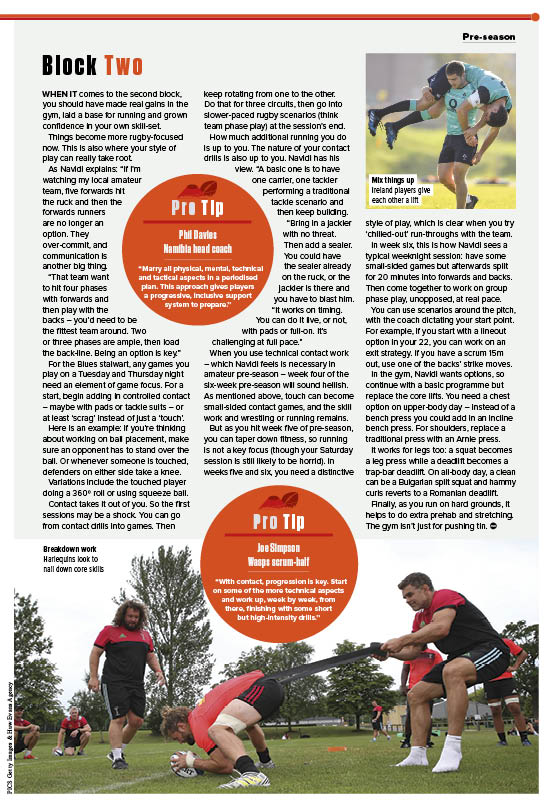Part two of our guide in which Rugby World – and Josh Navidi – get you in top shape for the new season
Rugby Pre-Season Guide: Part Two
Block Two
When it comes to the second block, you should have made real gains in the gym, laid a base for running and grown confidence in your own skill-set.
Things become more rugby-focused now. This is also where your style of play can really take root.
As Navidi explains: “If I’m watching my local amateur team, five forwards hit the ruck and then the forwards runners are no longer an option. They over-commit, and communication is another big thing.
“That team want to hit four phases with forwards and then play with the backs – you’d need to be the fittest team around. Two or three phases are ample, then load the back-line. Being an option is key.”
For the Blues stalwart, any games you play on a Tuesday and Thursday night need an element of game focus. For a start, begin adding in controlled contact – maybe with pads or tackle suits – or at least ‘scrag’ instead of just a ‘touch’.

Touch and run: Danny Qualter and James Rael
go through their paces in Connacht
Here is an example: if you’re thinking about working on ball placement, make sure an opponent has to stand over the ball. Or whenever someone is touched, defenders on either side take a knee.
Variations include the touched player doing a 360º roll or using squeeze ball.
Contact takes it out of you. So the first sessions may be a shock. You can go from contact drills into games. Then keep rotating from one to the other. Do that for three circuits, then go into slower-paced rugby scenarios (think team phase play) at the session’s end.
How much additional running you do is up to you. The nature of your contact drills is also up to you. Navidi has his view. “A basic one is to have one carrier, one tackler performing a traditional tackle scenario and then keep building.
“Bring in a jackler with no threat. Then add a sealer. You could have the sealer already on the ruck, or the jackler is there and you have to blast him.
“It works on timing. You can do it live, or not, with pads or full-on. It’s challenging at full pace.”
When you use technical contact work – which Navidi feels is necessary in amateur pre-season – week four of the six-week pre-season will sound hellish. As mentioned above, touch can become small-sided contact games, and the skill work and wrestling or running remains.
But as you hit week five of pre-season, you can taper down fitness, so running is not a key focus (though your Saturday session is still likely to be horrid). In weeks five and six, you need a distinctive style of play, which is clear when you try ‘chilled-out’ run-throughs with the team.
In week six, this is how Navidi sees a typical weeknight session: have some small-sided games but afterwards split for 20 minutes into forwards and backs. Then come together to work on group phase play, unopposed, at real pace.

Drilling down: Luke Wallace of Harlequins works on his breakdown skills
You can use scenarios around the pitch, with the coach dictating your start point. For example, if you start with a lineout option in your 22, you can work on an exit strategy. If you have a scrum 15m out, use one of the backs’ strike moves.
In the gym, Navidi wants options, so continue with a basic programme but replace the core lifts. You need a chest option on upper-body day – instead of a bench press you could add in an incline bench press. For shoulders, replace a traditional press with an Arnie press.
It works for legs too: a squat becomes a leg press while a deadlift becomes a trap-bar deadlift. On all-body day, a clean can be a Bulgarian split squat and hammy curls reverts to a Romanian deadlift.
Finally, as you run on hard grounds, it helps to do extra prehab and stretching. The gym isn’t just for pushing tin.
And then there’s our second Saturday session.







